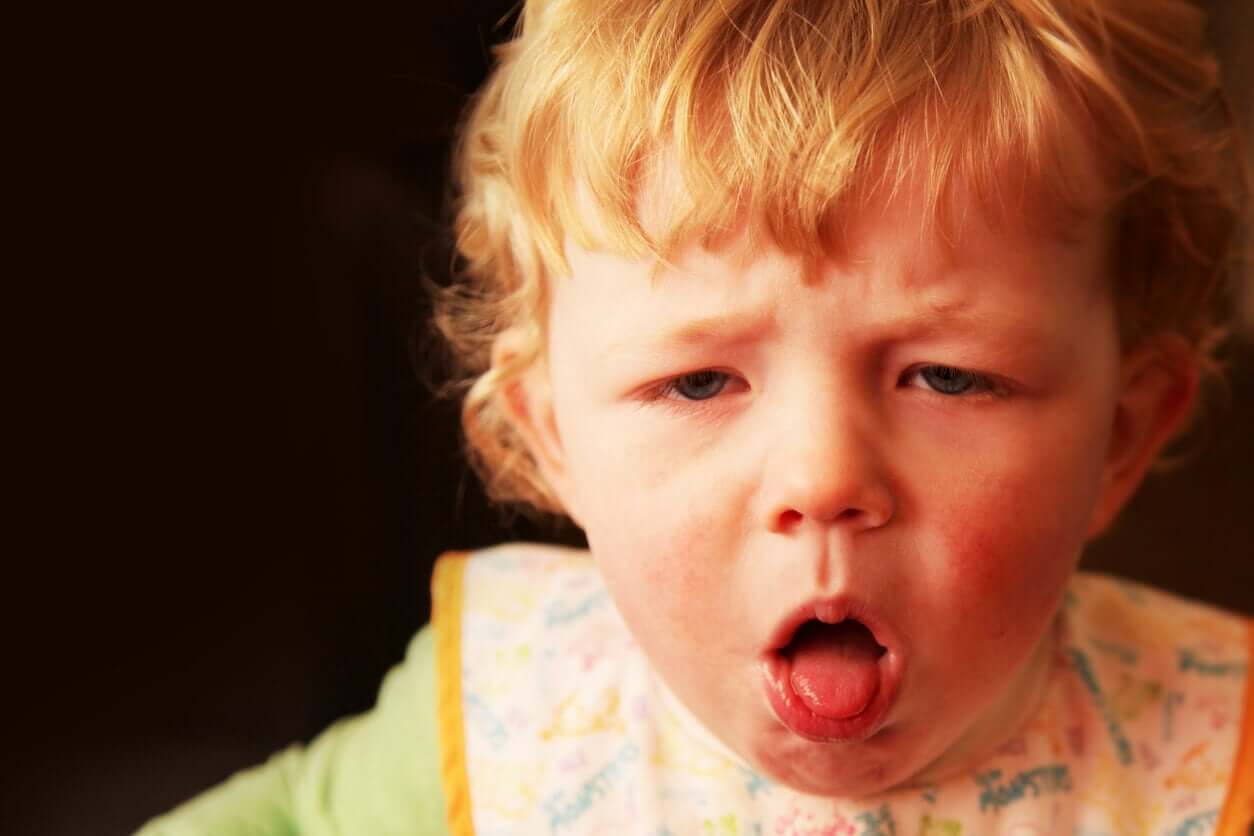How to Relieve a Dry Cough in Babies?

Coughing is one of the most frequent symptoms of childhood, at any time of the year. And among the different types, an irritating dry cough causes great concern in parents, especially when their children are babies.
Despite the inconvenience it causes to the child and their family, the truth is that coughing is a reflex defense mechanism of our body. If it didn’t exist, we would be extremely vulnerable to attack by microbes and particles in the air we breathe.
For this reason, it’s important to know which measures should be taken at home and which ones shouldn’t. Because the main idea is to alleviate the annoying symptom without causing further harm to babies. Keep reading!
A babies’ cough has a meaning
In general, coughing in babies is involuntary and responds to the protective reflex mechanisms of the airway. That’s to say, it’s a strategy that ensures that the path through which the air flows is free of obstacles.
The respiratory anatomy of babies is different from that of adults. Not only is it smaller, but it’s also more prone to clogging. This is due to the weakness and immaturity of the structures that surround it.
Every time the baby coughs, we must suppose that something is attacking their airway. So, our efforts should be aimed at solving the cause of the cough and not just extinguishing it.
What triggers a dry cough in babies?

Coughing is a complex nervous reflex that’s triggered by the stimulation of the respiratory walls, somewhere from the larynx to the bronchi. The receptors present in these structures are sensitive to physical stimuli (such as dust particles or mucus) and to chemicals (such as those that travel in tobacco smoke ).
When the brain receives the message that the airway is irritated or obstructed, it sends a signal to the respiratory muscles to contract and expel air at high speed. This is coughing.
Therefore, there are multiple causes for coughs in babies, and below, we’ll describe the most frequent:
- Upper airway infections (such as the early stages of a cold)
- Laryngitis
- Bronchitis
- Bronchiolitis
- Childhood asthma
- Whooping cough
- Allergic rhinitis
- Gastroesophageal reflux
- Congenital airway malformations (laryngomalacia, tracheoesophageal fistula, or vascular rings)
- Less common: Bronchiectasis, cystic fibrosis, immunodeficiencies
General measures to relieve a dry cough in babies
Sometimes, a cough can be a very bothersome symptom and interfere with certain vital functions, such as eating and sleeping. For this reason, many parents resort to various strategies in order to offer well-being to their babies.
However, we must be very cautious in this regard, as some remedies that seem innocuous can be quite harmful to children. And furthermore, they may not be as effective as you think.
Let’s look at some general steps that can be taken at home to alleviate a dry cough in babies.
1. Control air humidity
When the environment is cooled or heated with dry air, the respiratory mucosa becomes dehydrated and irritated easily. For this reason, it’s important to maintain a temperate climate inside the home and ensure a minimum level of humidity.
It’s important to note that excessive humidity in the environment favors the growth of microorganisms (such as fungi) and this can also cause a baby’s cough.
The permanent use of environmental vaporizers isn’t recommended and it’s best to avoid nebulization in small babies unless the pediatrician indicates otherwise.
You may also be interested: https://youaremom.com/babies/facts-babys-breathing/
2. Avoid environmental toxins
Pollution of the environment is a problem inside and outside the home. It’s essential that you reduce the presence of toxins in the environment as much as possible, especially when there are small babies in it. Therefore, you should avoid smoking and heating with inappropriate appliances inside the house.
3. Ventilate rooms and vacuum up dust
In both hot and cold seasons, it’s important to ventilate the rooms every day. This helps reduce the presence of dust particles and germs in the air and on surfaces.
4. Assure the baby has sufficient hydration
To improve irritation of the mucosa, you need to guarantee good hydration for your little one. Either with the breast, a bottle of milk, or water, if you’ve already started complementary feeding.
5. Raise the head of the crib
The safest sleeping position for babies is on their back, always. However, when the baby has a cold or coughs more when lying down, the head of the crib can be raised slightly to avoid discomfort.
Of course, the entire mattress must be raised, and it’s not a good idea to lay the baby on top of a pillow, due to the risk of suffocation.
6. Don’t offer honey to babies under 12 months of age
Although there’s some evidence in favor of the use of this food to relieve dry cough in children, its use in children under one year of age is contraindicated due to the risk of botulism.
In which cases does the dry cough of babies need to be treated with medication?

In general, it’s best to avoid the use of cough medications when the cause is unknown.
Only drugs that have been shown to be effective in treating specific conditions that cause coughing should be prescribed. For example, the use of bronchodilators in asthma or the use of antihistamines for allergic rhinitis.
According to a systematic review conducted by the Cochrane Collaboration in 2014, none of the over-the-counter medications (antihistamines, mucolytics, or cough suppressants) proved effective for cough relief in children.
When in doubt, it’s better to consult with a pediatrician
When your baby has a cough, it’s best to contact a pediatrician. Although these cases are recurrent in childhood, they’re not always identical and it’s important to examine the child in each case in order to decide on the most appropriate behavior.
Remember that not all remedies are effective in reality and many times, they can put the lives of children at risk.
Coughing is one of the most frequent symptoms of childhood, at any time of the year. And among the different types, an irritating dry cough causes great concern in parents, especially when their children are babies.
Despite the inconvenience it causes to the child and their family, the truth is that coughing is a reflex defense mechanism of our body. If it didn’t exist, we would be extremely vulnerable to attack by microbes and particles in the air we breathe.
For this reason, it’s important to know which measures should be taken at home and which ones shouldn’t. Because the main idea is to alleviate the annoying symptom without causing further harm to babies. Keep reading!
A babies’ cough has a meaning
In general, coughing in babies is involuntary and responds to the protective reflex mechanisms of the airway. That’s to say, it’s a strategy that ensures that the path through which the air flows is free of obstacles.
The respiratory anatomy of babies is different from that of adults. Not only is it smaller, but it’s also more prone to clogging. This is due to the weakness and immaturity of the structures that surround it.
Every time the baby coughs, we must suppose that something is attacking their airway. So, our efforts should be aimed at solving the cause of the cough and not just extinguishing it.
What triggers a dry cough in babies?

Coughing is a complex nervous reflex that’s triggered by the stimulation of the respiratory walls, somewhere from the larynx to the bronchi. The receptors present in these structures are sensitive to physical stimuli (such as dust particles or mucus) and to chemicals (such as those that travel in tobacco smoke ).
When the brain receives the message that the airway is irritated or obstructed, it sends a signal to the respiratory muscles to contract and expel air at high speed. This is coughing.
Therefore, there are multiple causes for coughs in babies, and below, we’ll describe the most frequent:
- Upper airway infections (such as the early stages of a cold)
- Laryngitis
- Bronchitis
- Bronchiolitis
- Childhood asthma
- Whooping cough
- Allergic rhinitis
- Gastroesophageal reflux
- Congenital airway malformations (laryngomalacia, tracheoesophageal fistula, or vascular rings)
- Less common: Bronchiectasis, cystic fibrosis, immunodeficiencies
General measures to relieve a dry cough in babies
Sometimes, a cough can be a very bothersome symptom and interfere with certain vital functions, such as eating and sleeping. For this reason, many parents resort to various strategies in order to offer well-being to their babies.
However, we must be very cautious in this regard, as some remedies that seem innocuous can be quite harmful to children. And furthermore, they may not be as effective as you think.
Let’s look at some general steps that can be taken at home to alleviate a dry cough in babies.
1. Control air humidity
When the environment is cooled or heated with dry air, the respiratory mucosa becomes dehydrated and irritated easily. For this reason, it’s important to maintain a temperate climate inside the home and ensure a minimum level of humidity.
It’s important to note that excessive humidity in the environment favors the growth of microorganisms (such as fungi) and this can also cause a baby’s cough.
The permanent use of environmental vaporizers isn’t recommended and it’s best to avoid nebulization in small babies unless the pediatrician indicates otherwise.
You may also be interested: https://youaremom.com/babies/facts-babys-breathing/
2. Avoid environmental toxins
Pollution of the environment is a problem inside and outside the home. It’s essential that you reduce the presence of toxins in the environment as much as possible, especially when there are small babies in it. Therefore, you should avoid smoking and heating with inappropriate appliances inside the house.
3. Ventilate rooms and vacuum up dust
In both hot and cold seasons, it’s important to ventilate the rooms every day. This helps reduce the presence of dust particles and germs in the air and on surfaces.
4. Assure the baby has sufficient hydration
To improve irritation of the mucosa, you need to guarantee good hydration for your little one. Either with the breast, a bottle of milk, or water, if you’ve already started complementary feeding.
5. Raise the head of the crib
The safest sleeping position for babies is on their back, always. However, when the baby has a cold or coughs more when lying down, the head of the crib can be raised slightly to avoid discomfort.
Of course, the entire mattress must be raised, and it’s not a good idea to lay the baby on top of a pillow, due to the risk of suffocation.
6. Don’t offer honey to babies under 12 months of age
Although there’s some evidence in favor of the use of this food to relieve dry cough in children, its use in children under one year of age is contraindicated due to the risk of botulism.
In which cases does the dry cough of babies need to be treated with medication?

In general, it’s best to avoid the use of cough medications when the cause is unknown.
Only drugs that have been shown to be effective in treating specific conditions that cause coughing should be prescribed. For example, the use of bronchodilators in asthma or the use of antihistamines for allergic rhinitis.
According to a systematic review conducted by the Cochrane Collaboration in 2014, none of the over-the-counter medications (antihistamines, mucolytics, or cough suppressants) proved effective for cough relief in children.
When in doubt, it’s better to consult with a pediatrician
When your baby has a cough, it’s best to contact a pediatrician. Although these cases are recurrent in childhood, they’re not always identical and it’s important to examine the child in each case in order to decide on the most appropriate behavior.
Remember that not all remedies are effective in reality and many times, they can put the lives of children at risk.
All cited sources were thoroughly reviewed by our team to ensure their quality, reliability, currency, and validity. The bibliography of this article was considered reliable and of academic or scientific accuracy.
- Galway NC, Shields MD. The child with an incessant dry cough. Paediatr Respir Rev. 2019 Apr;30:58-64. doi: 10.1016/j.prrv.2018.08.002. Epub 2018 Aug 30. PMID: 30962153. Disponible en: https://pubmed.ncbi.nlm.nih.gov/30962153/
- Oduwole O, Udoh EE, Oyo-Ita A, Meremikwu MM. Honey for acute cough in children. Cochrane Database of Systematic Reviews 2018, Issue 4. Art. No.: CD007094. DOI: 10.1002/14651858.CD007094.pub5. Disponible en: https://www.cochrane.org/es/CD007094/ARI_miel-para-la-tos-aguda-en-ninos
- American Academy of Pediatrics. La tos y el resfriado: ¿medicamentos o remedios caseros? Healthy children – APP. [Internet] 2018. Disponible en: https://www.healthychildren.org/Spanish/health-issues/conditions/chest-lungs/Paginas/Coughs-and-Colds-Medicines-or-Home-Remedies.aspx
- Smith SM, Schroeder K, Fahey T. Over-the-counter (OTC) medications for acute cough in children and adults in community settings. Cochrane Database of Systematic Reviews 2014, Issue 11. Art. No.: CD001831. DOI: 10.1002/14651858.CD001831.pub5. Disponible en: https://www.cochrane.org/es/CD001831/ARI_farmacos-de-venta-libre-fvl-para-la-tos-aguda-en-ninos-y-adultos-en-entornos-comunitarios
- Lamas A, et al. Tos en el niño. Arch Bronconeumol. 2014; 50(7):294–300. Disponible en: https://www.archbronconeumol.org/es-linkresolver-tos-el-nio-S0300289613003001
- Redondo Ridao M. Tos persistente. Pediatr Integral. 2012; 1; 13-20. Disponible en: https://www.pediatriaintegral.es/numeros-anteriores/publicacion-2012-01/tos-persistente/
This text is provided for informational purposes only and does not replace consultation with a professional. If in doubt, consult your specialist.








